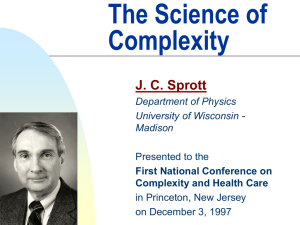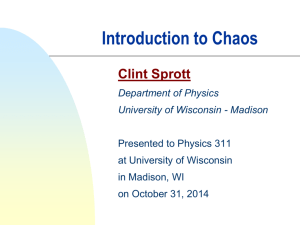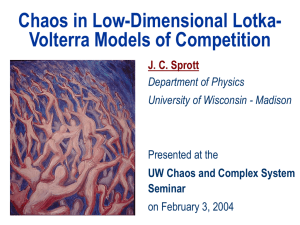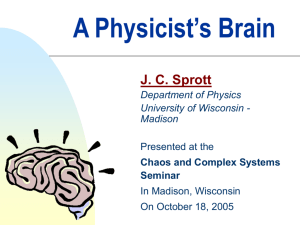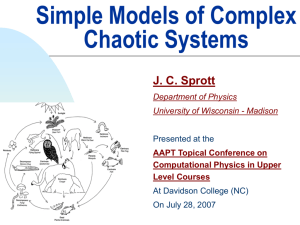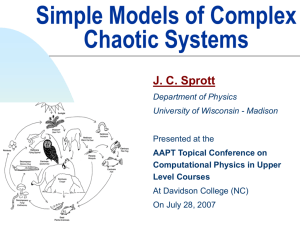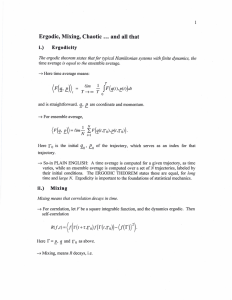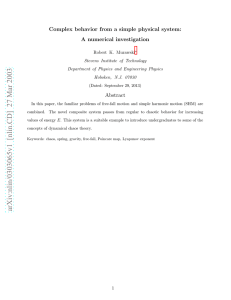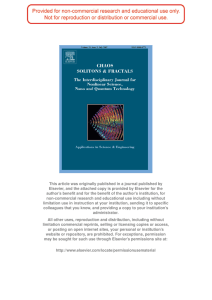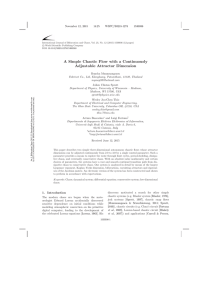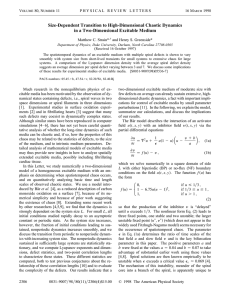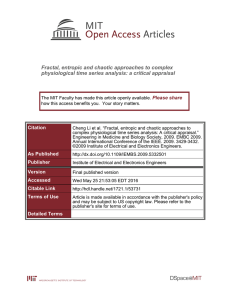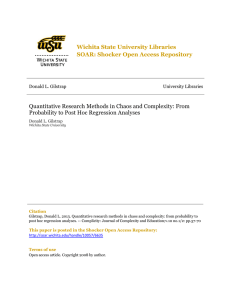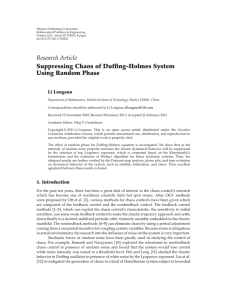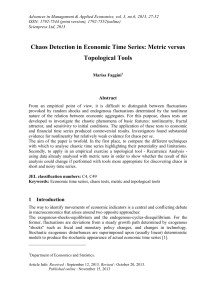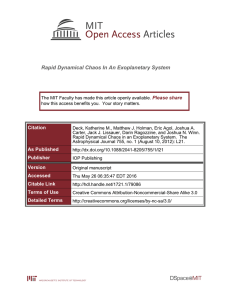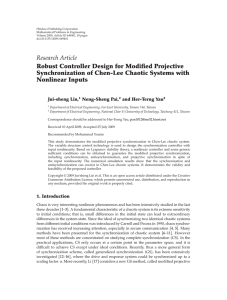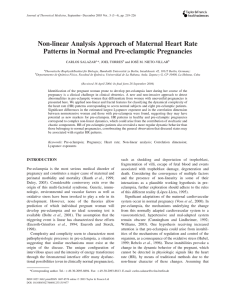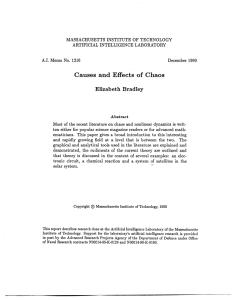Time-Series Analysis - University of Wisconsin
advertisement
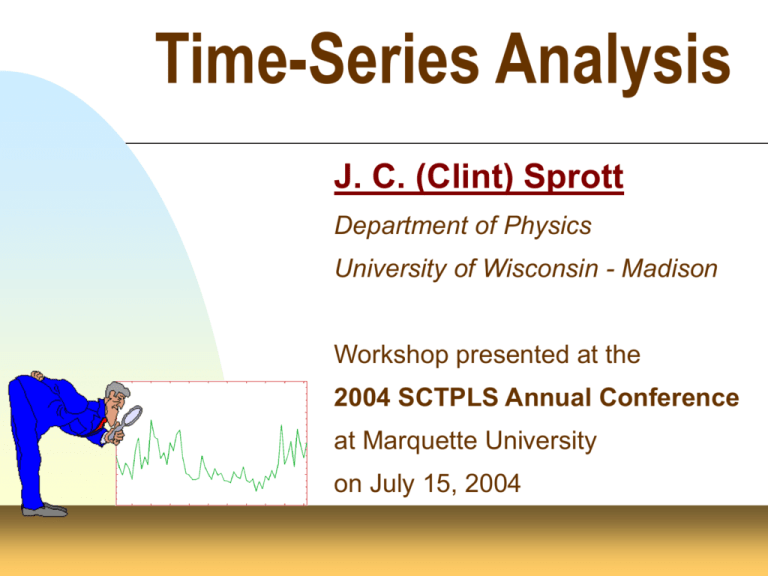
Time-Series Analysis J. C. (Clint) Sprott Department of Physics University of Wisconsin - Madison Workshop presented at the 2004 SCTPLS Annual Conference at Marquette University on July 15, 2004 Agenda Introductory lecture Hands-on tutorial Strange attractors – Break – Individual exploration Closing comments Motivation Many quantities in nature fluctuate in time. Examples are the stock market, the weather, seismic waves, sunspots, heartbeats, and plant and animal populations. Until recently it was assumed that such fluctuations are a consequence of random and unpredictable events. With the discovery of chaos, it has come to be understood that some of these cases may be a result of deterministic chaos and hence predictable in the short term and amenable to simple modeling. Many tests have been developed to determine whether a time series is random or chaotic, and if the latter, to quantify the chaos. If chaos is found, it may be possible to improve the short-term predictability and enhance understanding of the governing process. Goals This workshop will provide examples of time-series data from real systems as well as from simple chaotic models. A variety of tests will be described including linear methods such as Fourier analysis and autoregression, and nonlinear methods using statespace reconstruction. The primary methods for nonlinear analysis include calculation of the correlation dimension and largest Lyapunov exponent, as well as principal component analysis and various nonlinear predictors. Methods for detrending, noise reduction, false nearest neighbors, and surrogate data tests will be explained. Participants will use the "Chaos Data Analyzer" program to analyze a variety of typical timeseries records and will learn to distinguish chaos from colored noise and to avoid the many common pitfalls that can lead to false conclusions. No previous knowledge or experience is assumed. Precautions More art than science No sure-fire methods Easy to fool yourself Many published false claims Must use multiple tests Conclusions seldom definitive Compare with surrogate data Must ask the right questions “Is it chaos?” too simplistic Applications Prediction Noise reduction Scientific insight Control Examples Weather data Climate data Tide levels Seismic waves Cepheid variable stars Sunspots Financial markets Ecological fluctuations EKG and EEG data … (Non-)Time Series Core samples Terrain features Sequence of letters in written text Notes in a musical composition Bases in a DNA molecule Heartbeat intervals Dripping faucet Necker cube flips Eye fixations during a visual task ... Methods Linear (traditional) Fourier Analysis Autocorrelation ARMA LPC … Nonlinear (chaotic) State space reconstruction Correlation dimension Lyapunov exponent Principle component analysis Surrogate data … Resources Hierarchy of Dynamical Behaviors Typical Experimental Data 5 x -5 0 Time 500 Stationarity Detrending Detrended Case Study First Return Map Time-Delayed Embedding Space Plot x(t) vs. x(t-), x(t-2), x(t-3), … Embedding dimension is # of delays Must choose and dim carefully Orbit does not fill the space Diffiomorphic to actual orbit Dim of orbit = min # of variables x(t) can be any measurement fcn Measurement Functions Hénon map: Xn+1 = 1 – 1.4X2 + 0.3Yn Yn+1 = Xn Correlation Dimension N(r) rD2 D2 = dlogN(r)/dlogr Inevitable Ambiguity Lyapunov Exponent Rn = R0 n e = <ln|Rn/R0|> Principal Component Analysis x(t) State-space Prediction Surrogate Data Original time series Shuffled surrogate Phase randomized General Strategy Verify integrity of the data Test for stationarity Look at return maps, etc. Look at autocorrelation function Look at power spectrum Calculate correlation dimension Calculate Lyapunov exponent Compare with surrogate data sets Construct models Make predictions from models Tutorial using CDA Types of Attractors Fixed Point Focus Limit Cycle Node Torus Strange Attractor Strange Attractors Limit set as t Set of measure zero Basin of attraction Fractal structure Chaotic dynamics non-integer dimension self-similarity infinite detail sensitivity to initial conditions topological transitivity dense periodic orbits Aesthetic appeal Individual Exploration using CDA Practical Considerations Calculation speed Required number of data points Required precision of the data Noisy data Multivariate data Filtered data Missing data Nonuniformly sampled data Nonstationary data Some General High-Dimensional Models N Fourier Series: x(t ) ao a cosit b sin it i i1 i N Linear Autoregression: x(t ) ao a x(t i) noise i i1 (ARMA, LPC, MEM…) N N Nonlinear Autogression: x(t ) ao x(t i) a a x(t j) ij i i 1 j 1 (Polynomial Map) Neural Network: N D x(t ) bo b tanh a x(t j) i1 i j1 ij Artificial Neural Network Summary Nature is complex but Simple models may suffice References http://sprott.physics.wisc.edu/lec tures/tsa.ppt (this presentation) http://sprott.physics.wisc.edu/cd a.htm (Chaos Data Analyzer) sprott@physics.wisc.edu (my email)
